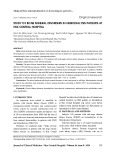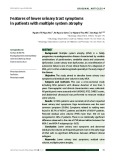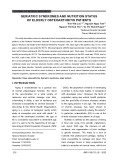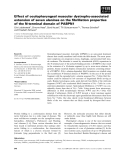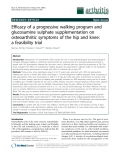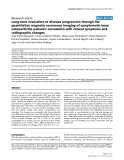
Progressive symptoms
-
Early detection and correction of calcium-phosphate imbalances to improve symptoms of hyperuremia, slow the progression of chronic kidney disease and reduce the risk of death from cardiovascular complications and renal osteodystrophy dues to secondary hyperparathyroidism.
 7p
7p  viormkorn
viormkorn
 27-09-2024
27-09-2024
 1
1
 1
1
 Download
Download
-
Multiple system atrophy (MSA) is a fatally progressive neurodegenerative disease characterized by variable combinations of parkinsonism, cerebellar ataxia and autonomic dysfunction. The study aimed to describe lower urinary tract symptoms and residual urine volume in early MSA.
 7p
7p  viormkorn
viormkorn
 27-09-2024
27-09-2024
 4
4
 1
1
 Download
Download
-
This study describes numerous characteristics of comorbidities and geriatric syndromes in elderly osteoarthritis patients at the National Geriatrics Hospital. A cross-sectional study on 184 knee osteoarthritis (OA) patients aged ≥ 60 years old treated at the National Geriatrics Hospital.
 10p
10p  vihawkeye
vihawkeye
 26-05-2023
26-05-2023
 6
6
 2
2
 Download
Download
-
Oculopharyngeal muscular dystrophy (OPMD) is an autosomal dominant disease that usually manifests itself within the fifth decade. The most prom-inent symptoms are progressive ptosis, dysphagia, and proximal limb mus-cle weakness. The disorder is caused by trinucleotide (GCG) expansions in the N-terminal part of the poly(A)-binding protein 1 (PABPN1) that result in the extension of a 10-alanine segment by up to seven more alanines.
 10p
10p  inspiron33
inspiron33
 23-03-2013
23-03-2013
 49
49
 4
4
 Download
Download
-
Tuyển tập các báo cáo nghiên cứu về y học được đăng trên tạp chí y học General Psychiatry cung cấp cho các bạn kiến thức về ngành y đề tài: Efficacy of a progressive walking program and glucosamine sulphate supplementation on osteoarthritic symptoms of the hip and knee: a feasibility trial...
 15p
15p  thulanh14
thulanh14
 19-10-2011
19-10-2011
 52
52
 5
5
 Download
Download
-
Tuyển tập các báo cáo nghiên cứu về y học được đăng trên tạp chí y học General Psychiatry cung cấp cho các bạn kiến thức về ngành y đề tài:Long term evaluation of disease progression through the quantitative magnetic resonance imaging of symptomatic knee osteoarthritis patients: correlation with clinical symptoms and radiographic changes...
 12p
12p  thulanh12
thulanh12
 13-10-2011
13-10-2011
 51
51
 5
5
 Download
Download
-
Clinical Manifestations Food-Borne Botulism After ingestion of food containing toxin, illness varies from a mild condition for which no medical advice is sought to very severe disease that can result in death within 24 h. The incubation period is usually 18–36 h but, depending on toxin dose, can range from a few hours to several days. Symmetric descending paralysis is characteristic and can lead to respiratory failure and death. Cranial nerve involvement, which almost always marks the onset of symptoms, usually produces diplopia, dysarthria, dysphonia, and/or dysphagia.
 5p
5p  colgate_colgate
colgate_colgate
 21-12-2010
21-12-2010
 78
78
 3
3
 Download
Download
-
Paraneoplastic myelitis may present with upper or lower motor neuron symptoms, segmental myoclonus, and rigidity. This syndrome can appear as the presenting manifestation of encephalomyelitis and may be associated with SCLC and serum anti-Hu, anti-CV2/CRMP5, or anti-amphiphysin antibodies. Paraneoplastic myelopathy can also produce several syndromes characterized by prominent muscle stiffness and rigidity.
 5p
5p  thanhongan
thanhongan
 07-12-2010
07-12-2010
 75
75
 4
4
 Download
Download
-
Metastatic Disease: Castrate Castration-resistant disease can manifest in many ways. For some it is a rise in PSA with no change in radiographs and no new symptoms. In others it is a rising PSA and progression in bone with or without symptoms of disease. Still others will show soft tissue disease with or without osseous metastases, and others have visceral spread. The prognosis, which is highly variable, can be predicted using nomograms designed for the castration-resistant disease state.
 5p
5p  konheokonmummim
konheokonmummim
 03-12-2010
03-12-2010
 75
75
 4
4
 Download
Download
-
Clinical Features About 10% of esophageal cancers occur in the upper third of the esophagus (cervical esophagus), 35% in the middle third, and 55% in the lower third. Squamous cell carcinomas and adenocarcinomas cannot be distinguished radiographically or endoscopically. Progressive dysphagia and weight loss of short duration are the initial symptoms in the vast majority of patients. Dysphagia initially occurs with solid foods and gradually progresses to include semisolids and liquids.
 5p
5p  konheokonmummim
konheokonmummim
 03-12-2010
03-12-2010
 95
95
 4
4
 Download
Download
-
Allergic contact dermatitis (ACD). A. An example of ACD in its acute phase, with sharply demarcated, weeping, eczematous plaques in a perioral distribution. B. ACD in its chronic phase demonstrating an erythematous, lichenified, weeping plaque on skin chronically exposed to nickel in a metal snap. (B, Courtesy of Robert Swerlick, MD; with permission.) As in other branches of medicine, a complete history should be obtained to emphasize the following features: 1. Evolution of lesions a. Site of onset b. Manner in which the eruption progressed or spread c. Duration d.
 5p
5p  konheokonmummim
konheokonmummim
 30-11-2010
30-11-2010
 72
72
 9
9
 Download
Download
-
Approach to the Patient: Erectile Dysfunction A good physician-patient relationship helps to unravel the possible causes of ED, many of which require discussion of personal and sometimes embarrassing topics. For this reason, a primary care provider is often ideally suited to initiate the evaluation. A complete medical and sexual history should be taken in an effort to assess whether the cause of ED is organic, psychogenic, or multifactorial (Fig. 492). Initial questions should focus on the onset of symptoms, the presence and duration of partial erections, and the progression of ED.
 5p
5p  ongxaemnumber1
ongxaemnumber1
 29-11-2010
29-11-2010
 54
54
 5
5
 Download
Download
-
Approach to the Patient: Disorders of the Sense of Hearing The goal in the evaluation of a patient with auditory complaints is to determine (1) the nature of the hearing impairment (conductive vs. sensorineural vs. mixed), (2) the severity of the impairment (mild, moderate, severe, profound), (3) the anatomy of the impairment (external ear, middle ear, inner ear, or central auditory pathway), and (4) the etiology. The history should elicit characteristics of the hearing loss, including the duration of deafness, unilateral vs. bilateral involvement, nature of onset (sudden vs.
 5p
5p  ongxaemnumber1
ongxaemnumber1
 29-11-2010
29-11-2010
 83
83
 5
5
 Download
Download
-
Myogenic Ptosis The causes of myogenic ptosis include myasthenia gravis (Chap. 381) and a number of rare myopathies that manifest with ptosis. The term chronic progressive external ophthalmoplegia refers to a spectrum of systemic diseases caused by mutations of mitochondrial DNA. As the name implies, the most prominent findings are symmetric, slowly progressive ptosis and limitation of eye movements. In general, diplopia is a late symptom because all eye movements are reduced equally. In the Kearns-Sayre variant, retinal pigmentary changes and abnormalities of cardiac conduction develop.
 5p
5p  ongxaemnumber1
ongxaemnumber1
 29-11-2010
29-11-2010
 60
60
 5
5
 Download
Download
-
Recurrent unilateral labyrinthine dysfunction, in association with signs and symptoms of cochlear disease (progressive hearing loss and tinnitus), is usually due to Ménière's disease (Chap. 30). When auditory manifestations are absent, the term vestibular neuronitis denotes recurrent monosymptomatic vertigo. Transient ischemic attacks of the posterior cerebral circulation (vertebrobasilar insufficiency) only infrequently cause recurrent vertigo without concomitant motor, sensory, visual, cranial nerve, or cerebellar signs (Chap. 364).
 6p
6p  ongxaemnumber1
ongxaemnumber1
 29-11-2010
29-11-2010
 66
66
 6
6
 Download
Download
CHỦ ĐỀ BẠN MUỐN TÌM








